
at Velo Cult last night.
(Photo © J. Maus/BikePortland)
The Bicycle Transportation Alliance has embarked on their 2013 legislative campaign. Last night they revealed that the three bills they plan to lobby for center around funding, speed limits, and enforcement.
The bills are substantial and they mark a full-force return to lobbying in Salem after the BTA opted to lay low and rebuild relationships with legislators in the 2011 session.
At a BTA-hosted happy hour event at Velo Cult Bike Shop last night, Advocacy Director Gerik Kransky shared that their “three-pronged approach” is “all about safety.”
Their flagship bill is the Safe Neighborhood Streets Act of 2013 that would give all cities in Oregon the authority to lower speed limits on neighborhood streets from 25 mph (the current default) to 20 mph. You might recall that the City of Portland successfully lobbied for a speed limit reduction law in the 2011 session. The City won authority to lower speed limits to 20 mph only on streets where safe biking and walking infrastructure has been added (like neighborhood greenways).
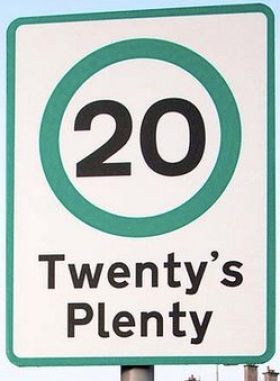
common throughout the UK.
(Photo: 20’s Plenty for Us)
The BTA bill, “Would be expanding on the ’20’s plenty’ concept,” said Kransky last night. “We’re saying 20’s plenty in the neighborhoods where people live and children play.” (Note: 20’s Plenty is an advocacy movement that covers much of the U.K. and other parts of Europe.)
Kransky said he doesn’t expect much opposition to the bill. “There are not a lot of reasons to oppose reductions in speed when it comes to safety, especially on neighborhood streets where we feel it should be more of a public space.”
Another bill the BTA will push for that’s related to speed is expected to be a much heavier lift. Kransky said they’re putting together a bill that would expand the concept of “remote enforcement.” The idea would be similar to existing red-light cameras in that no police officer would need to be present. Current Oregon law allows photo radar vans to be set up; but they must have an officer inside them and they can only be used four hours at a time. The BTA bill will seek to expand existing Oregon law to make unmanned photo radar cameras legal. The idea would be to place these cameras on “high-crash corridors” — larger arterial streets where data shows a high number of crashes and/or high speeds.
In addition to these speed-related bills, the BTA is also working on a bill that would increase funding for “non-roadway” bike paths/trails, sidewalks, and transit operations (as opposed to capital infrastructure) projects. The bill is called Connect Oregon Plus and it’s based on the existing Connect Oregon program administered by the Oregon Department of Transportation. Connect Oregon (also known as the Multimodal Transportation Fund) has been around since 2005 and is funded by state lottery-backed bonds. Historically, this pot of money was created to fund non-roadway projects that are not eligible for funding through the highway trust fund (gas tax). Unfortunately for bike advocates, biking and walking projects have never been eligible for Connect Oregon funds because the law only mentions “air, marine, rail, and public transit infrastructure improvements.” (I have been perplexed and frustrated for many years that bike projects are not listed!).
Back in 2009, bike advocates attempted to amend the language of the existing Connect Oregon law to add the words “non-motorized transportation” to the list of eligible projects; but they weren’t successful.
Connect Oregon has historically doled out about $100 million per biennium, so to convince existing interests to share that pot 50/50 with biking, walking, and transit projects will not be easy. That is, unless the BTA and their partners can help grow the overall pie considerably. Kransky says they’re seeking to expand the program to as much as $180 million and that if Connect Oregon Plus is successful, it would split that amount 50/50 among the existing project categores and the new, bike/walk/transit category.
Connect Oregon V, a bill that would continue the program in its current form, has already been introduced in the legislature and Kransky said that bill, “Will be our sparring mate as we have these conversations about Connect Oregon Plus.”
This is a full plate of lobbying for the BTA. In years past, they’ve had a staffer of their own down in Salem. This year (like last session), they’ve hired a contract lobbyist to work on their behalf and assist them in weaving through the legislative process. In addition to their three main bills, the BTA will undoubtedly also work to oppose bills that are not good for biking and they might assist on other bike-related bills as they arise.
The 2013 session starts the first week of February. Stay tuned for full coverage.

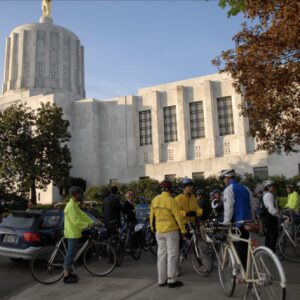
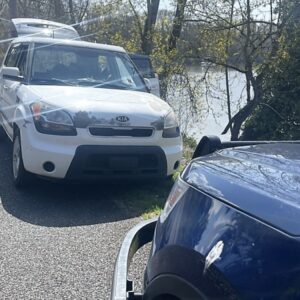
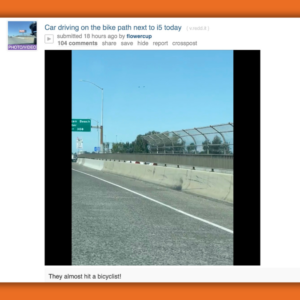
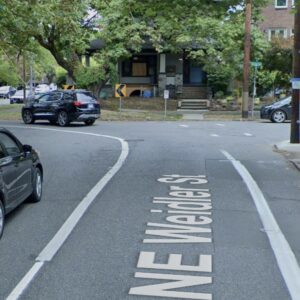
Thanks for reading.
BikePortland has served this community with independent community journalism since 2005. We rely on subscriptions from readers like you to survive. Your financial support is vital in keeping this valuable resource alive and well.
Please subscribe today to strengthen and expand our work.
Would love to see some red light cameras installed throughout the city particularly along bike paths in which I-5 dodgers take.
“Unlike past years, they won’t have a staffer of their own down in Salem. Instead, they’ve hired a contract lobbyist to work on their behalf and assist them in weaving through the legislative process”
Do we know why? Is the contract lobbyist more experienced or have better connections? Are they short on cash? Do they feel staff time is better spent elsewhere? I can’t tell if this is a good thing or a bad thing.
These three initiatives seem like great ideas. It’s interesting that they are not particularly bike oriented. A pro-transit or pro-walking group would likely advocate for these same things.
love that sign, for some reason in the US ppl feel like they need to travel faster? 45 thru- places ppl live.. ahh
And anyone who gets hit is at fault for “getting in the way”.
This feels like beating a dead horse, but lower speed limits won’t mean squat unless the attitude toward enforcement changes. I was told point blank by someone at PBOT, and this was confirmed by the person I spoke to at the 823-SAFE line, that the cops would not ticket anyone speeding down our street unless “they are doing 11-14 mph over the limit.” On our street, a 25mph street, that means that a driver needs to be doing pretty much 50% over the limit to get a ticket.
In my 13 years in Portland I have NEVER seen a speed enforcement on any neighborhood street. You see them on 99 or other arterials where there are far fewer vulnerable road users, but NOT in neighborhoods. It’s totally backward from what it should be.
Add to that a need for crosswalk enforcements at UNmarked crosswalks.
I’d like to see people getting pulled over for going 1mph over the limit on any road, resulting in maybe just a warning… 5mph over should always be a ticket… doesn’t matter if it’s Powell or I-205, it’s the LIMIT, not the MINIMUM…
“but lower speed limits won’t mean squat unless the attitude toward enforcement changes. ”
I disagree. Speed limits are one step, and if we have to do one before the other, probably the better one to get right first. Of course enforcement is important and we have to work on that too.
Spending all our money on killing people in other countries also undoes or precludes a lot of potential good we could do here at home, but that doesn’t (to me) mean we shouldn’t chip away at all the problems we have with what little scraps are left over after the Pentagon has enjoyed the main course.
tonyt: “Add to that a need for crosswalk enforcements at UNmarked crosswalks.”
Amen. Unmarked crosswalks are largely ignored by vehicle traffic, and it seems that almost all of the enforcement actions are at marked crosswalks.
I’ve been screamed at by drivers (“That’s not a crosswalk!”) when I expected them to yield (with PLENTY of warning) to me at unmarked crosswalks. Most drivers are TOTALLY ignorant as to this law.
Especially on neighborhood streets with speed limits 20mph or so, 11-14 mph over the limit, is way too much slack given. 6 or 7 and above would be generous.
I know I’ve read in past comments/stories addressing this subject, reasons given by police for that high 11-14 mph margin over of the limit before ticketing, but can’t remember exactly what they were. Didn’t seem particularly sensible.
What I was told (by the same PBOT person who confessed to the 11-14 buffer) was that below that threshold, drivers are likely to fight it and judges are likely to let it slide and therefore sending a cop to court and losing the case COSTS the traffic division money instead of bringing in revenue.
It would be a good idea to get out in front of the complaints about remote enforcement, and specify testing of new cameras to ensure that their false-positive rate is acceptably low, and to periodically audit/review already-installed cameras to be sure that they are working properly.
The cameras have been in use in the UK for more than a decade with negligible false positives. They have been in use in Europe even longer.
BTA has had a contract lobbyist rather than a staffer in salem for at least two years.
while i am sure it would be lovely to have additional funding for offroad bike/ped facilities, i am very sorry to see any progressive activist seeking to become dependent on lottery money.
Very happy to see the BTA get back in the game of pushing bills in Salem. Education is a great thing mind you, but when the current laws are not on your side education can only go so far.
Are you sure that that London “twenty’s plenty” means 20 miles per hour? A decade ago, Britan was pretty thoroughly metric, and I would have assumed that the sign meant 20 km per hour, or 12 mph. Bikes need to slow down too.
I was there just a few years ago; the “20” is Mph.
Yes but…
(Note: 20’s Plenty is an advocacy movement that covers much of the U.K. and other parts of Europe.)
Charles McCarthy’s larger point is correct:
The rest of Europe would be very unlikely to be covered by this. They have 30km signs instead 🙂
And 30 km is 18 miles, so it’s even lower! We should really be pushing for 15 mph limits on residential streets as a round number, in the long-term, considering how the culture here is to drive 5 or 10 mph over the speed limit
Which recalls Ivan Illich’s famous suggestion of a universal 15mph speed limit, which would effectively remove any advantage from motorized transport over, say, bicycles.
“The central theme of Illich’s writings has been that the true history of economic growth is the history of evergrowing scarcity. Beyond a certain point, he argues, technological progress is counterproductive. It leads to environmental degradation and it defeats its own ends: the faster the means of travel, the greater the congestion and the longer the delays. Moreover, growth seriously disadvantages those who are excluded from it. The more automobiles and motorways there are in Los Angeles, the more impossible becomes the life of the pedestrian. Illich even puts it forward as a law that diminishing returns are bound to set in when people try to travel at more than 15 m.p.h.”
BTA, you’re going to want to be careful about using ‘crash rate’ to define a problem. Crash rate is based on crashes relative to number of users and a period of time. This is done to compare roads objectively, though low volume streets can send the numbers through the roof. For example, 100 crashes over 5 years at an intersection that serves 50,000 vehicles per day is a crash rate of about 1.2 crashes per million entering vehicles. 5 crashes over 5 years at an intersection that serves 250 entering vehicles is a crash rate of 11.8. Which should you spend money on?
Hey ScottB,
Thanks for the comment… The “crash rate” term is mine. Not the BTA’s. I should have been more careful. The BTA will use state/city crash data to determine locations… not crash rate.
Big loophole in automated radar since it seems like anyone driving a fleet vehicle gets a pass, and big fleet trucks seem to be the most dangerous vehicles for cyclists.
As long as we’re talking about lowering speed limits, why aren’t the major collectors part of the conversation? I can’t fathom why we need 45 and 55 mph speed limits on non-freeway streets.
Enforcement is definitely needed, whether automated or not. The only consistent enforcement I see is on Cedar Hills Blvd., where there’s often a Beaverton PD van sitting with a camera. Everywhere else, if I’m driving the speed limit, I’m getting passed right and left.
I’m not sure how a 20 mph speed limit in a neighborhood makes a big difference when drivers are consistently doing 60 down Cornell or 185th, right alongside bus stops and skinny bike lanes. Seems to me that if we’re talking safety, it should apply everwhere.
There frequently is a photo speed van parked at various points on Canyon Rd between West Slope and Canyon Ln. How many speeders they catch, I wouldn’t know, but tend to think their mere presence helps. I frequently have to drive that section of the road, so I’m seeing the traffic generally keep to the speed limit. Sometimes a speeder will zip ahead…spot the van and jam on the brakes. The flash from the van can be a beautiful thing.
I’ll give the BTA ‘thumbs up’ on its efforts to have unmanned photo radar cameras made legal. The intersection at Beaverton at Beav/Hillsdale Hwy and Griffith Pkwy has red light cameras. After dark, from the nearby coffee shop, at times, those camera flashes going off is like a little light show.
Thanks for this coverage, Jonathan. I really appreciate your work on bike issues. Our hope with this agenda is to make safety front and center to every legislative conversation about bikes.
Also, one quick point on Connect Oregon Plus. If we successfully expand the program it will fund bike, pedestrian, and transit capital projects AND transit and passenger rail operations. Small distinction from the way it is captured above.
example time: Wilsonvile Rd 45? told this police officer wow thats fast he said its need to be higher? whoa some fokes, ppl drive 50 on it with houses and kids other cars etc… its all about money.. since Wilsonvile even has its own traffic court. lol
“BTA bill will seek to expand existing Oregon law to make unmanned photo radar cameras legal.”
I’m rather shocked that BTA is promoting an expansion of the surveilance state.
And get real, BTA will NOT be the decision maker as to where those surveilance units will be placed if that law passes.